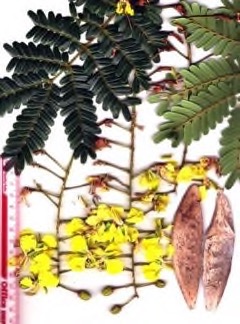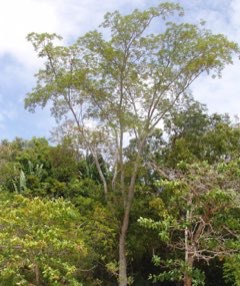 |
|
JJLudemann wikimedia.org |
 |
| C. Davidson wikimedia.org |
Translate this page:
Summary
A natural pioneer species, Peltophorum dasyrhachis is a deciduous flowering tree reaching a height of up to 30m. The bole is straight and around 50 - 90cm in diameter. The crown is open and diffuse. It has drooping racemes comprised of yellow flowers. The tree is commonly grown across Southeast Asia and in Africa. The plant has high content of polyphenolic substances, hence decomposition rate of its leaf litter is slow. As a result, weed growth is suppressed and soil erosion is minimized. Young plants are shade tolerant while established plants are drought tolerant. The plant is also tolerant to fire due to its thick and hairy bark. The bark is used medicinally in the treatment of coughs. The wood is heavy and durable but prone to insect and termite attacks. It is used for planks, furniture, boards, posts, and as firewood.
Physical Characteristics

 Peltophorum dasyrhachis is a deciduous Tree growing to 25 m (82ft) by 25 m (82ft) at a fast rate.
Peltophorum dasyrhachis is a deciduous Tree growing to 25 m (82ft) by 25 m (82ft) at a fast rate.
See above for USDA hardiness. It is hardy to UK zone 10.
It can fix Nitrogen.
Suitable for: medium (loamy) and heavy (clay) soils and prefers well-drained soil. Suitable pH: mildly acid, neutral and basic (mildly alkaline) soils. It can grow in semi-shade (light woodland) or no shade. It prefers moist soil.
UK Hardiness Map
US Hardiness Map
Synonyms
Baryxylum dasyrhachis (Miq.) Pierre Caesalpinia dasyrhachis Miq. Peltophorum grande Prain Peltophoru
Plant Habitats
Edible Uses
References More on Edible Uses
Medicinal Uses
Plants For A Future can not take any responsibility for any adverse effects from the use of plants. Always seek advice from a professional before using a plant medicinally.
Antitussive
The bark is used in an infusion to treat coughs[303 ].
References More on Medicinal Uses
The Bookshop: Edible Plant Books
Our Latest books on Perennial Plants For Food Forests and Permaculture Gardens in paperback or digital formats.

Edible Tropical Plants
Food Forest Plants for Hotter Conditions: 250+ Plants For Tropical Food Forests & Permaculture Gardens.
More

Edible Temperate Plants
Plants for Your Food Forest: 500 Plants for Temperate Food Forests & Permaculture Gardens.
More

More Books
PFAF have eight books available in paperback and digital formats. Browse the shop for more information.
Shop Now
Other Uses
Fuel Furniture Hedge Mulch Pioneer Soil reclamation Soil stabilization Wood
Agroforestry Uses: The tree is a natural pioneer species, quickly invading open areas in the forests and abandoned agricultural land[598 ]. Its use in the reclamation of Imperata cylindrica grasslands is being tested; in Indonesia and Malaysia, young trees planted in tall Imperata grassland and left untended after planting remained alive, but grew slowly[303 ]. Due to a fairly high content of polyphenolic substances, decomposition of the leaf litter is slow, allowing a humus layer to build up in the soil[310 ]. This slow rate of decomposition reduces soil erosion and also contributes to the suppression of weeds[303 ]. Seeds of Imperata cylindrica hardly germinate in soil covered by the leaves[303 ]. The tree has been used as a shade tree, mainly in coffee plantations[303 ]. It is sometimes maintained after bush fallow as a shade tree for fruit trees and for its role in soil improvement[303 ]. When unpruned, it provides a rather dense shade to control weeds during fallow periods, and can be managed in hedges without too much shading of inter-row crops[303 ]. Because its growth rate is slower than that of Leucaena leucocephala and Gliricidia sepium, it requires less frequent pruning[303 ]. Plants can be pruned to form a dense hedge[303 ]. Other Uses The heartwood is red-yellow to brownish; it is distinctly demarcated from the white-grey sapwood. The wood is heavy, brittle, rather durable though attacked by termites and boring insects[303 ]. Another report says that it is termite resistent[443 ]. It is used locally for planks in house-building, but is of little market value[303 ]. The wood is utilized for the production of furniture, boards, posts, and wood pavement as well as in the building of houses and vehicles[317 ]. The wood is used for fuel[303 , 404 ].
Special Uses
Hedge Nitrogen Fixer
References More on Other Uses
Cultivation details
A plant of the moist tropics, where it is usually found at elevations from sea level up to 1,000 metres[303 ]. It grows best in areas with a mean annual rainfall in the range 700 - 2,500mm and a dry season of 1 - 3 months, with a mean annual temperature of 20 - 25°c and the average temperature of the coldest month is not lower than 15°c[303 ]. Young plants are shade tolerant but the plant requires a sunny position as it grows larger[303 , 404 ]. In the wild, the tree grows on many reddish yellow feralit soils on mica schist, gneiss, reddish basalt, sedimentary soil.[303 ]. Due to its relatively deep rooting system, established plants are drought tolerant[303 ]. The tree has a fairly thick bark and is hairy, helping it to be fairly tolerant of fire[303 ]. The seed germinates in abundance after a bush fire[303 ]. The trees can be pruned quite severely and usually resprout abundantly[303 ]. The root system comprises a well-developed taproot and a few superficial lateral roots[303 ]. This species has a symbiotic relationship with certain soil bacteria, these bacteria form nodules on the roots and fix atmospheric nitrogen. Some of this nitrogen is utilized by the growing plant but some can also be used by other plants growing nearby[200 ].
References Carbon Farming Information and Carbon Sequestration Information
Temperature Converter
Type a value in the Celsius field to convert the value to Fahrenheit:
Fahrenheit:
The PFAF Bookshop
Plants For A Future have a number of books available in paperback and digital form. Book titles include Edible Plants, Edible Perennials, Edible Trees,Edible Shrubs, Woodland Gardening, and Temperate Food Forest Plants. Our new book is Food Forest Plants For Hotter Conditions (Tropical and Sub-Tropical).
Shop Now
Plant Propagation
Seed - it can store for at least 2 years with little loss of viability. The seed will benefit from presoaking in warm water prior to sowing[404 ]. Cuttings.
Other Names
If available other names are mentioned here
soga, petaian - Indonesian; saph'ang, sa f'ang - Sino-Tibetan/Lao; jemerelang, batai - Malay; nonsi, arang - Thai.
Native Range
TROPICAL ASIA: Cambodia, Laos, Thailand, Vietnam, Indonesia (Jawa, Sumatera), Malaysia (Malaya)
Weed Potential
Right plant wrong place. We are currently updating this section.
Please note that a plant may be invasive in one area but may not in your area so it's worth checking.
Conservation Status
IUCN Red List of Threatened Plants Status : This taxon has not yet been assessed

Growth: S = slow M = medium F = fast. Soil: L = light (sandy) M = medium H = heavy (clay). pH: A = acid N = neutral B = basic (alkaline). Shade: F = full shade S = semi-shade N = no shade. Moisture: D = dry M = Moist We = wet Wa = water.
Now available:
Food Forest Plants for Mediterranean Conditions
350+ Perennial Plants For Mediterranean and Drier Food Forests and Permaculture Gardens.
[Paperback and eBook]
This is the third in Plants For A Future's series of plant guides for food forests tailored to
specific climate zones. Following volumes on temperate and tropical ecosystems, this book focuses
on species suited to Mediterranean conditions—regions with hot, dry summers and cool, wet winters,
often facing the added challenge of climate change.
Read More
Expert comment
Author
(Miq.) Kurz
Botanical References
Links / References
For a list of references used on this page please go here
A special thanks to Ken Fern for some of the information used on this page.
Readers comment
| Add a comment |
|
If you have important information about this plant that may help other users please add a comment or link below. Only comments or links that are felt to be directly relevant to a plant will be included. If you think a comment/link or information contained on this page is inaccurate or misleading we would welcome your feedback at [email protected]. If you have questions about a plant please use the Forum on this website as we do not have the resources to answer questions ourselves.
* Please note: the comments by website users are not necessarily those held by PFAF and may give misleading or inaccurate information.
To leave a comment please Register or login here All comments need to be approved so will not appear immediately.
|
Subject : Peltophorum dasyrhachis
|
|
|
|